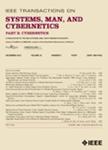版权所有:内蒙古大学图书馆 技术提供:维普资讯• 智图
内蒙古自治区呼和浩特市赛罕区大学西街235号 邮编: 010021

作者机构:Dept. of Biophys. & Electron. Eng. Genoa Univ. Italy Department of Biophysical and Electronic Engineering University of Genoa Genoa Italy
出 版 物:《IEEE TRANSACTIONS ON SYSTEMS MAN AND CYBERNETICS PART B-CYBERNETICS》 (IEEE Trans Syst Man Cybern Part B Cybern)
年 卷 期:1996年第26卷第1期
页 面:1-20页
核心收录:
主 题:Adaptive systems Image processing Optical filters Data mining Partitioning algorithms Optical sensors Filtering Image edge detection Phase estimation Optical propagation
摘 要:A distributed optimization framework and its application to the regulation of the behavior of a network of interacting image processing algorithms are presented. The algorithm parameters used to regulate information extraction are explicitly represented as state variables associated with all network nodes. Nodes are also provided with message-passing procedures to represent dependences between parameter settings at adjacent levels. The regulation problem is defined as a joint-probability maximization of a conditional probabilistic measure evaluated over the space of possible configurations of the whole set of state variables (i.e., parameters). The global optimization problem is partitioned and solved in a distributed way, by considering local probabilistic measures for selecting and estimating the parameters related to specific algorithms used within the network. The problem representation allows a spatially varying tuning of parameters, depending on the different informative contents of the subareas of an image. An application of the proposed approach to an image processing problem is described. The professing chain chosen as an example consists of four modules. The first three algorithms correspond to network nodes. The topmost node is devoted to integrating information derived from applying different parameter settings to the algorithms of the chain. The nodes associated with data-transformation processes to be regulated are represented by an optical sensor and two filtering units (for edge-preserving and edge-extracting filterings), and a straight-segment detection module is used as an integration site. Each module is provided with knowledge concerning the parameters to regulate the related processing phase and with specific criteria to estimate data quality. Messages can be bidirectionally propagated among modules in order to search, in a distributed way, for the optimum set of parameters yielding the best solution. Experimental results obtained on indoor